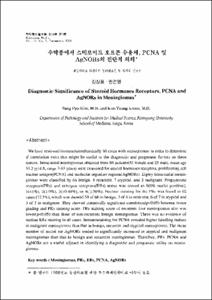수막종에서 스테로이드 호르몬 수용체; PCNA 및 AgNORs의 진단적 의의
- Keimyung Author(s)
- Kim, Sang Pyo; Kwon, Kun Young
- Journal Title
- Keimyung Medical Journal
- Issued Date
- 2000
- Volume
- 19
- Issue
- 2
- Keyword
- Meningiomas; PRs; Ers; PCNA; AgNORs
- Abstract
- We have reviewed immunohistochemically 80 cases with meningiomas in order to determine if correlation exist that might be useful as the diagnostic and prognostic factors on these tumors. Intracranial meningiomas obtained from 80 patients(55 female and 25 male, mean age 51.2±14.8, range 7-83 years) were examined for steroid hormones receptors, proliferating cell nuclear antigen(PCNA) and nucleolar organizer regions(AgNORs). Eighty intracranial meningiomas were classified by 66 benign, 4 recurrent, 7 atypical, and 3 malignant. Progesterone receptors(PRs) and estrogen receptors(ERs) status was scored as 0(0% nuclei positive), 1(<1%), 2(1-9%), 3(10-49%), or 4(≥50%). Nuclear staining for the PRs was found in 62 cases (77.5%), which was showed 50 of 66 in benign, 3 of 4 in recurrent, 6 of 7 in atypical and 3 of 3 in malignant. They showed statistically significant correlation(p<0.05) between tumor grading and PRs staining score. PRs staining score of recurrent four meningiomas also was lower(p<0.05) than those of non-recurrent benign meningiomas. There was no evidence of nuclear ERs staining in all cases. Immunostaining for PCNA revealed higher labelling indices in malignant meningiomas than that in benign, recurrent and atypical meningiomas. The mean number of nuclei for AgNORs tended to significantly increased in atypical and malignant meningiomas than that in benign and recurrent meningiomas. Therefore, PRs, PCNA and AgNORs are a useful adjunct in identifying a diagnostic and prognostic utility on meningiomas.
- Alternative Title
- Diagnostic Significance of
Steroid Hormones Receptors; PCNA and
AgNORs in Meningiomas*
- Publisher
- Keimyung University School of Medicine
- Citation
- 김상표 and 권건영. (2000). 수막종에서 스테로이드 호르몬 수용체; PCNA 및 AgNORs의 진단적 의의. Keimyung Medical Journal, 19(2), 159–170.
- Type
- Article
- 파일 목록
-
-
Download
 19-159.pdf
기타 데이터 / 1.16 MB / Adobe PDF
19-159.pdf
기타 데이터 / 1.16 MB / Adobe PDF
-
Items in Repository are protected by copyright, with all rights reserved, unless otherwise indicated.